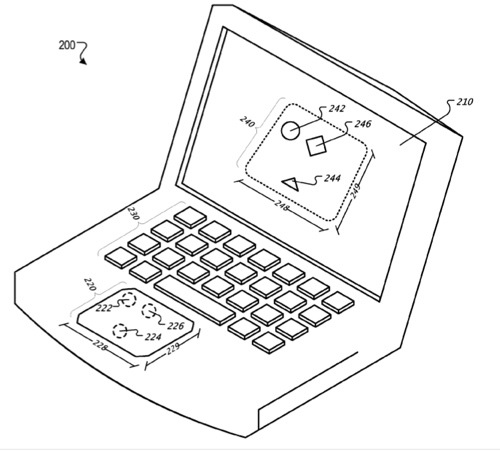An Apple patent (number 20100245250) for virtual input tools hint at some potentially fascinating developments in upcoming versions of the Mac OS X.
A virtual input device, e.g., a virtual representation of a physical input device, is disclosed. In one aspect, virtual coordinates of the virtual input device correlate to real coordinates on the physical input device. Dimensions of the physical input device are proportional to dimensions of the virtual input device, and interactive objects are presented in the virtual input device. The inventor is John O. Louch.
Here’s Apple’s background and summary of the invention: “Traditional user interfaces allow a user to navigate between one or more interface elements (e.g., application windows) through the use of physical input devices (e.g., a keyboard, mouse, trackpad or touchpad). For example, a user can press a combination of keys (e.g., Command+Tab) on a keyboard to cycle between the one or more interface elements. As another example, a user could use a mouse or trackpad to search for and activate (e.g., by clicking on) individual interface elements in the user interface.
“In particular, input received at an initial position on a trackpad can be compared to subsequent positions of input received on the trackpad. The relative change from the initial position to the subsequent positions determines an amount and direction of movement of a cursor, for example, from the cursor’s current position in the user interface. In other words, the cursor’s movement is based on a relative change in positions of input received through the trackpad. Because the cursor’s movement is based on the relative change in positions on the trackpad, a position on the trackpad does not correspond to a single position in the traditional user interface. In addition, interaction between the user and the interface depends on the initial position of the cursor in the interface.
“Other methods of navigating to interface elements are possible. Nevertheless, as the number of interface elements in the user interface increases, the difficulty or inconvenience of interacting with (e.g., navigating to or controlling) a desired interface element may increase.
“A virtual input device, e.g., a virtual representation of a physical input device, is disclosed. In one aspect, virtual coordinates of the virtual input device correlate to real coordinates on the physical input device. Dimensions of the physical input device are proportional to dimensions of the virtual input device, and interactive objects are presented in the virtual input device.
“Particular embodiments of the subject matter described in this specification can be implemented to realize one or more of the following advantages. Virtual representations of input devices, that can include interactive, virtual representations of objects (e.g., application windows, applications, directories), allow a user to navigate to the objects more efficiently, thereby improving an ease of interacting with the objects and improving a user’s experience. A virtual representation of an input device can be a two-dimensional area that increases an amount of data (e.g., virtual representations of objects) that can be presented at a particular time, thereby improving the user’s experience.
“Furthermore, the virtual representations of the input devices can have dimensions that are proportional to the input devices (e.g., physical input devices). As a result, the user can interact with an interface more efficiently because input provided by the user through the input device corresponds visually with indications of that input in the virtual input device. In particular, a user does not have to look at the input device when interacting with the virtual input device, as the user can expect that his/her input through the input device will correspond to similar input (or interaction) at the virtual input device. In addition, because each position on the virtual device corresponds to a single position on the physical device, a user can navigate through an entire virtual space of the virtual device (e.g., up to and including the borders of the virtual representation) using a single gesture (e.g., by keeping a user’s finger down on a trackpad).”

